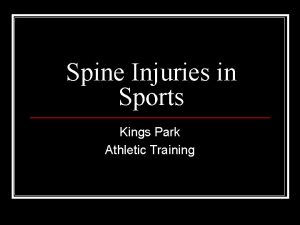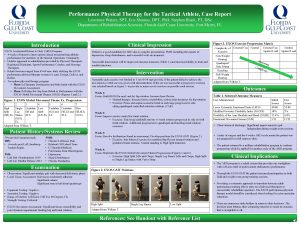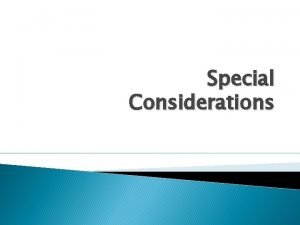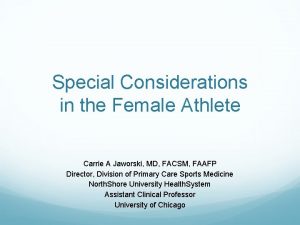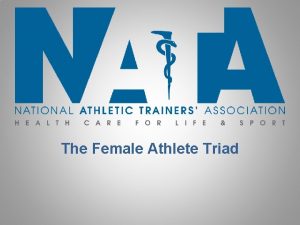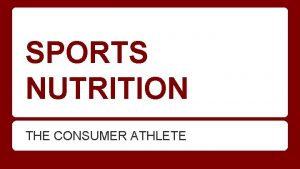Special Considerations in the Transgender Athlete Carrie A




































- Slides: 36

Special Considerations in the Transgender Athlete Carrie A Jaworski, MD, FACSM, FAAFP Director, Division of Primary Care Sports Medicine North. Shore University Health. System Assistant Clinical Professor University of Chicago

The Transgender Athlete Estimated prevalence of 390 in 100, 000 in the U. S. Paucity of literature on topic Increased media attention around controversies with transgender athlete participation Chapters now in the PPE monograph as well as the NCAA handbook The sports physical is the easy part! Understanding the other aspects is essential Policy changes in sport, inclusion, testing, etc.

Definition of terms Transgender individuals are those who identify as a gender different than their sex designated at birth Gender affirmation (gender reassignment) – the process and period of time where an individual is transitioning to a new gender. Can include physical, social, medical, legal, and surgical components Gender dysphoria – Distress experienced by individual who has a gender identity different than that designated at birth Ever evolving terms Best to ask athlete their preference on terms

Additional relevant terms Dubon M, Abbott K, Carl R. Care of the Transgender Athlete. Curr Sports Med Reports. Dec 18 17(12) 410 -18.

Additional relevant terms Dubon M, Abbott K, Carl R. Care of the Transgender Athlete. Curr Sports Med Reports. Dec 18 17(12) 410 -18.

Epidemiology of the transgender athlete Research suggests decreased physical activity and sports participation in the transgender population Lack of access to inclusive environments Negative experiences with competitive sports based on restrictive policies on their participation Medical and surgical interventions interfere with participation Treatments are time consuming Waiting periods after hormonal or surgical interventions

Medical Interventions – Transgender males Hormone therapy Testosterone – menses usually stops within a few months If no cessation, progestestional agents or endometrial ablation can be considered Occasional pretreatment with Gn. RH analogs or medroxyprogesterone agents prior to testosterone to decrease estrogen and cessation of menses

Medical interventions – Transgender females Hormone therapy Treated with antiandrogen and estrogen therapy Spironolactone most commonly used in the U. S. High risk of thromboembolic events with use of ethinyl estradiol Advised against use in the 2017 consensus ‘‘Endocrine Treatment of Gender-Dysphoric/Gender-Incongruent Persons: An Endocrine Society Clinical Practice Guideline’’ Need to submit therapeutic use exemption forms for use of hormones in elite athlete population

Gender affirmation surgery: transgender males ‘‘Top surgeries’’ = mastectomy and chest wall reconstruction ‘‘Bottom surgeries’’ include: hysterectomy, salpingooophorectomy, vaginectomy, urethroplasty, metoidioplasty, phalloplasty, and/or either scrotoplasty or testicular prosthetic insertion, in addition to hormone therapy Many transgender male athletes opt to only do the “top” surgeries

Gender affirmation surgery: transgender females ‘‘Top surgery’’: breast augmentation ‘‘Bottom surgeries’’: Penectomy, orchidectomy Clitoroplasty, labiaplasty, and/or vaginoplasty, in addition to hormone therapy. Some transgender females may choose to have facial feminization surgery, hair removal, and/or shaving down of the tracheal cartilage

Historical approach to the transgender athlete IOC convened ad hoc group resulting in the Stockholm Consensus in 2003 Transgender males and females who had transitioned prior to puberty were allowed to compete in respective categories Those who transitioned after puberty had much stricter rules: Required surgery - external genitalia surgery and gonadectomy Legally documented recognition of their gender identity Hormone therapy (which had to have been administered in a way that was verifiable and for a long enough period suitable to the committee) It was recommended for gonadectomy to be performed at least 2 years before competition

IOC transgender athletes The IOC consensus statement “Sex Reassignment and Hyperandrogenism” updated in 2015 Removed requirement for surgery and legal declaration of gender identity International Olympic Committee. IOC Consensus Meeting on Sex Reassignment and Hyperandrogenism, November 2015. Lausanne, Switzerland: International Olympic Committee; 2015. https: //stillmed. olympic. org/Documents/Commissions_PDFfiles/Medical_commission/2015‐ 11_ioc_consensus_ meeting_on_sex_reassignment_and_hyperandrogenism‐en. pdf.

IOC transgender athletes Those who transition from female to male are eligible to compete as a male without restriction. Those who transition from male to female must meet these requirements to compete as a female: Declare gender identity as female. Can’t change back for 4 years Total serum testosterone level is below 10 nmol/L for at least 12 months prior to her first competition Level must remain below 10 nmol/L throughout period of desired eligibility to compete in the female category. Subject to monitoring and can be ineligible for 12 mos. if fail

Controversies over policy The eligibility of transgender females to compete as females without orchiectomy and the total testosterone level allowed to compete has prompted significant debate Potential performance‐enhancing benefits from previous exposure to male hormones for a transgender girl/woman competing against biologically born girls/women Female athletes have protested citing elimination of the positive effects of Title IX

Controversies over policy Research demonstrates that transgender female athletes can have testosterone and hemoglobin levels within the female reference range within a year of gonadectomy. Some “case study” data suggest that performance of transgender women is reduced approximately 10% compared with age‐grade performance measures within a few weeks of testosterone suppression.

Controversies over policy In transgender female athletes that haven’t had surgery, there is concern for “cheating the system” by manipulating suppression medications to allow testosterone levels to rise during training to enhance performance. Most transgender women athletes will reduce testosterone levels below the required limit for psychosocial reasons. Similarly, transgender men could abuse their testosterone dosing in training for a performance advantage

NCAA transgender athletes Document “NCAA Inclusion of Transgender Student‐Athletes” outlines policy Transgender male athletes not utilizing hormonal therapy for gender transition may participate on a men’s or women’s team Transgender female athletes not utilizing hormonal therapy for gender transition may not participate on a women’s team NCAA inclusion of transgender student-athletes. NCAA Office of Inclusion, 2011

NCAA transgender athletes A transgender male student athlete diagnosed with gender dysphoria who has received an exception to be treated with testosterone can compete on a male team. No longer eligible to compete on a woman’s team, unless it is designated as a mixed team

NCAA transgender athletes A transgender female student athlete being treated with testosterone suppression for gender dysphoria may continue to compete on a men’s team, but needs to be treated for one calendar year before competing on a woman’s team (else it need be a mixed team)

High school transgender athletes National Federation of State High School Associations (NFHS) Policies set at state and local levels Heavy reliance on Title IX The NFHS has nonbinding recommendations in the document “Developing Policies for Transgender Students on High School Teams, ” which has suggested resources for state associations http: //www. nfhs. org/articles/developing‐policies‐for‐transgender‐students‐on‐h school‐ teams.

High School policies

High school policies State laws prohibiting discrimination in schools based on sexual orientation or gender identity As of January 1, 2017, 14 jurisdictions had enacted such legislation (CA, CO, CT, IA, IL, MA, ME, MN, NJ, NY, OR, VT, WA, DC) and bills are pending in numerous other states.


Transgender athletes in the news Kristen Worley - Canadian transgender female cyclist Reached a settlement with Cycling Canada, Ontario Cycling Association, and the Union Cycliste Internationale (UCI) in 2017 Claimed that their hormone range restrictions prevented her from participating in her sport at an elite level and endangered her health

Transgender athletes in the news Chris Mosier is a transgender male duathlon athlete who advocated for a change to the IOC policy for participation of transgender athletes, helping to inspire the 2015 changes. He became the first known transgender member of a men’s US National team First known transgender athlete to compete in a World Championship race for the International Triathlon Union (ITU) in sprint duathlon

Transgender athletes in the news Mack Beggs - a transgender male competitive wrestler in Texas who, while in high school, wished to participate as male, consistent with his gender identity Due to the policy of the Texas high school athletic association, the University Interscholastic League (UIL), he was required to compete in the female category, as this was his sex designated at birth Concern about unfair advantage over cisgender females due to his testosterone therapy Undefeated in both 2017 and 2018.

Thinking ahead… As more individuals with gender dysphoria are identified early, medical interventions will be started sooner and result in the onset of puberty being blocked Thus the effects of innate sex hormone on muscle and bone development may be eliminated and the perceived advantages will be eliminated

Medical considerations – Bone Transgender females prior to hormone treatment have lower bone mineral densities compared to both age matched males or transgender males based on presumed decreased access to activity Study of transgender individuals on hormone therapy showed: A small increase in bone mineral density at the lumbar spine of transgender women receiving hormone therapy No evidence for significant bone mineral density changes in transgender men receiving hormone therapy Individuals who cease hormone therapy after gonadectomy may be at a higher risk of bone loss/low bone mineral density Singh-Ospina N, Maraka S, Rodriguez-Gutierrez R, et al. Effect of sex steroids on the bone health of transgender individuals: a systematic review and meta-analysis. J. Clin. Endocrinol. Metab. 2017; 102: 3904 Y 13

Medical considerations - MSK Musculoskeletal issues – no studies to date demonstrate differences in injury rates Take into account gender affirmation surgeries when caring for athletes Shoulder, neck or chest wall pain with mastectomies or breast augmentation Post-operative pelvic floor dysfunction as source of hip/pelvic issues

Medical considerations - CV Thromboembolic risk associated with estrogen use Avoidance of the use of ethinyl estradiol Preferential use of transdermal estrogen, which decreases risk by avoidance of hepatic first pass metabolism Testosterone use can lower LDL and raise HDL and TG but no conclusive evidence of increased CV risk Routine monitoring of lipid panels and CV risk factors Hembree WC, Cohen-Kettenis PT, Gooren L, et al. Endocrine treatment of gender-dysphoric/genderincongruent persons: an endocrine society clinical practice guideline. Endocr. Pract. 2017; 23: 1437.

Medical considerations – Mental Health In a 2018 study of transgender high school aged youth, 33% reported non-suicidal self-harm and 18% reported non-suicidal self-harm and suicide attempts within the past year. Higher risk of co-morbidities: Depression, anxiety, suicidality and substance abuse Higher rates of disordered eating Bullying, exclusion issues Taliaferro LA, Mc. Morris BJ, Rider GN, Eisenberg ME. Risk and protective factors for selfharm in a population-based sample of transgender youth. Arch. Suicide Res. 2018; 1 -19.

Medical considerations - GU The practice of tucking can lead to hernia, urinary reflux, prostatism, epididymo-orchitis, prostatis, or cystitis in transgender females Transgender females may experience genital pain with start of hormone therapy Need to consider hernia, hydrocele, or tumor with scrotal pain Recalcitrant pain should consider orchiectomy Transgender males may experience pelvic pain for a variety of reasons Atrophic vaginitis, UTI, pelvic floor dysfunction, dyspareunia, posttestosterone cramping, infectious vaginitis, cervicitis, STI, pregnancy, sequelae of sexual trauma, postsurgical pain or complications such as adhesions or scar tissue If pain is cyclical, adjust testosterone regimen in conjunction with those managing the hormone treatment Dubon M, Abbott K, Carl R. Care of the Transgender Athlete. Curr Sports Med Reports. Dec 18 17(12) 410 -18

Environmental considerations Create an environment of inclusion Educate the sports team, athletics staff, and sports medical staff about terminology and pronouns Be aware of facilities and include a gender neutral option

Up to date information The site, https: //www. transathlete. com/, created by Chris Mosier includes up-to-date information on the policies of various sports organizations throughout the world

Take home points The process for approving transgender athletes for competition is rapidly changing and will continue to evolve Providing sport participation clearance is often the “simple” part of the process Stay attuned to changes in rules on participation Don’t neglect the mental health aspect in this athlete population

Learn more at… Deutsch MB. Guidelines for the primary and genderaffirming care of transgender and gender nonbinary people 2016. Available from: http: //transhealth. ucsf. edu/pdf/Transgender-PGACG-6 -1716. pdf.
 Trans umbrella diagram
Trans umbrella diagram Transgender
Transgender Transgender umbrella
Transgender umbrella Transgender
Transgender What does the bible say about being transgender
What does the bible say about being transgender Transgender umbrella
Transgender umbrella Wat is genderkoek
Wat is genderkoek Trans empowerment project
Trans empowerment project Ihsa handbook
Ihsa handbook What is transgender
What is transgender Genogram multiple marriages
Genogram multiple marriages Pulse
Pulse Embarrass suffix
Embarrass suffix Matthews motshwarateu
Matthews motshwarateu My favorite athlete is
My favorite athlete is Venn diagram communicable and noncommunicable diseases
Venn diagram communicable and noncommunicable diseases Possessive n
Possessive n The athlete machine
The athlete machine Purpose of circuit training
Purpose of circuit training What is lyric poetry narrative poetry
What is lyric poetry narrative poetry Which athlete has the most olympic gold medals
Which athlete has the most olympic gold medals To an athlete dying young tone
To an athlete dying young tone Back pain kings park
Back pain kings park Corporate athlete model
Corporate athlete model Possessive form of athlete
Possessive form of athlete What path does a projectile follow
What path does a projectile follow Tactical athlete physical therapy
Tactical athlete physical therapy Athlete's circle of care definition
Athlete's circle of care definition Register my athlete login
Register my athlete login The bus athlete
The bus athlete Sports team marketing plan
Sports team marketing plan Pele greatest athlete of all time
Pele greatest athlete of all time Olympic athlete
Olympic athlete Windshield hits bug reaction
Windshield hits bug reaction An athlete throws a javelin to a maximum distance of 80m
An athlete throws a javelin to a maximum distance of 80m Bioreactor considerations for animal cell culture
Bioreactor considerations for animal cell culture Cloud delivery models
Cloud delivery models






















